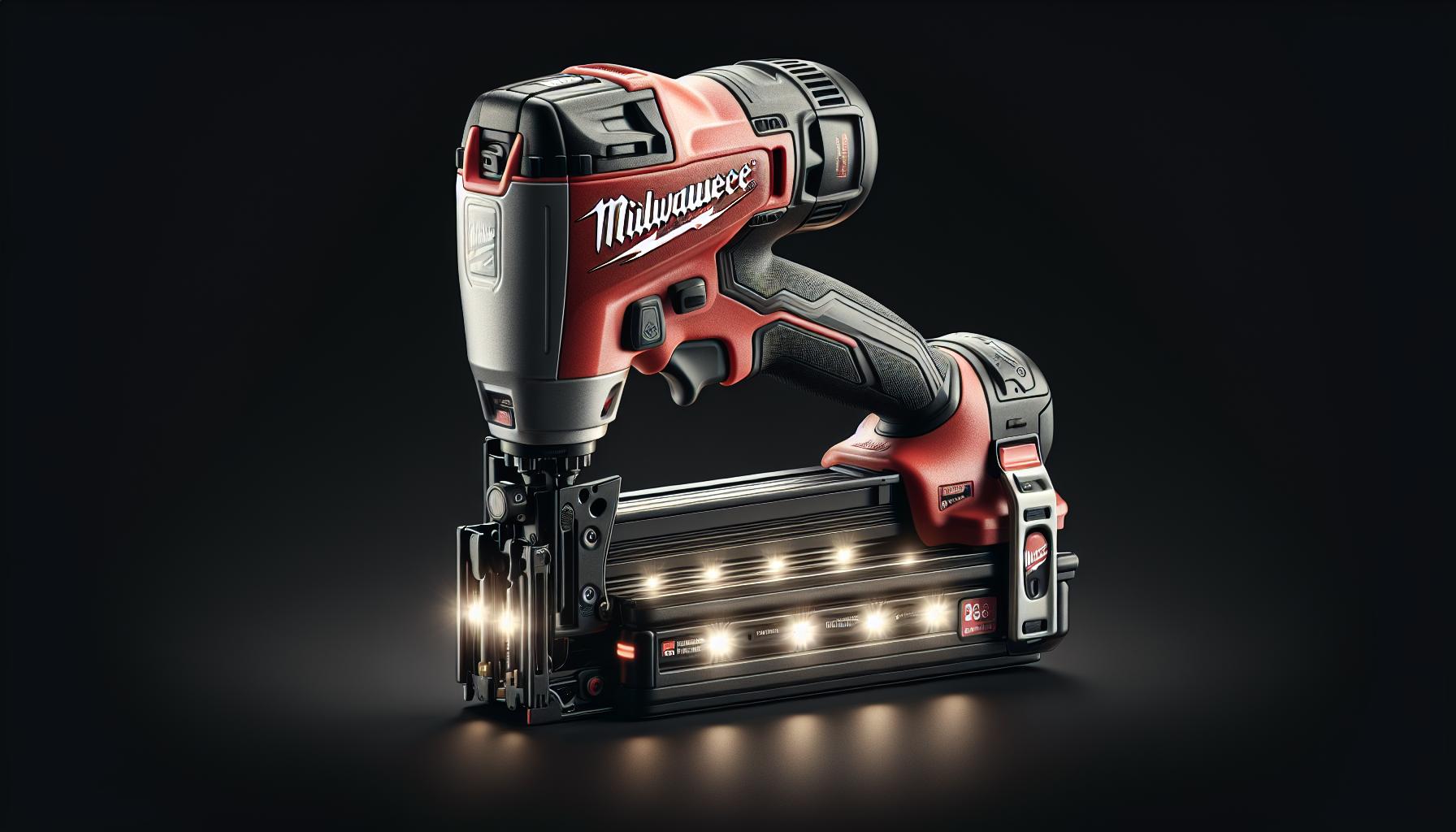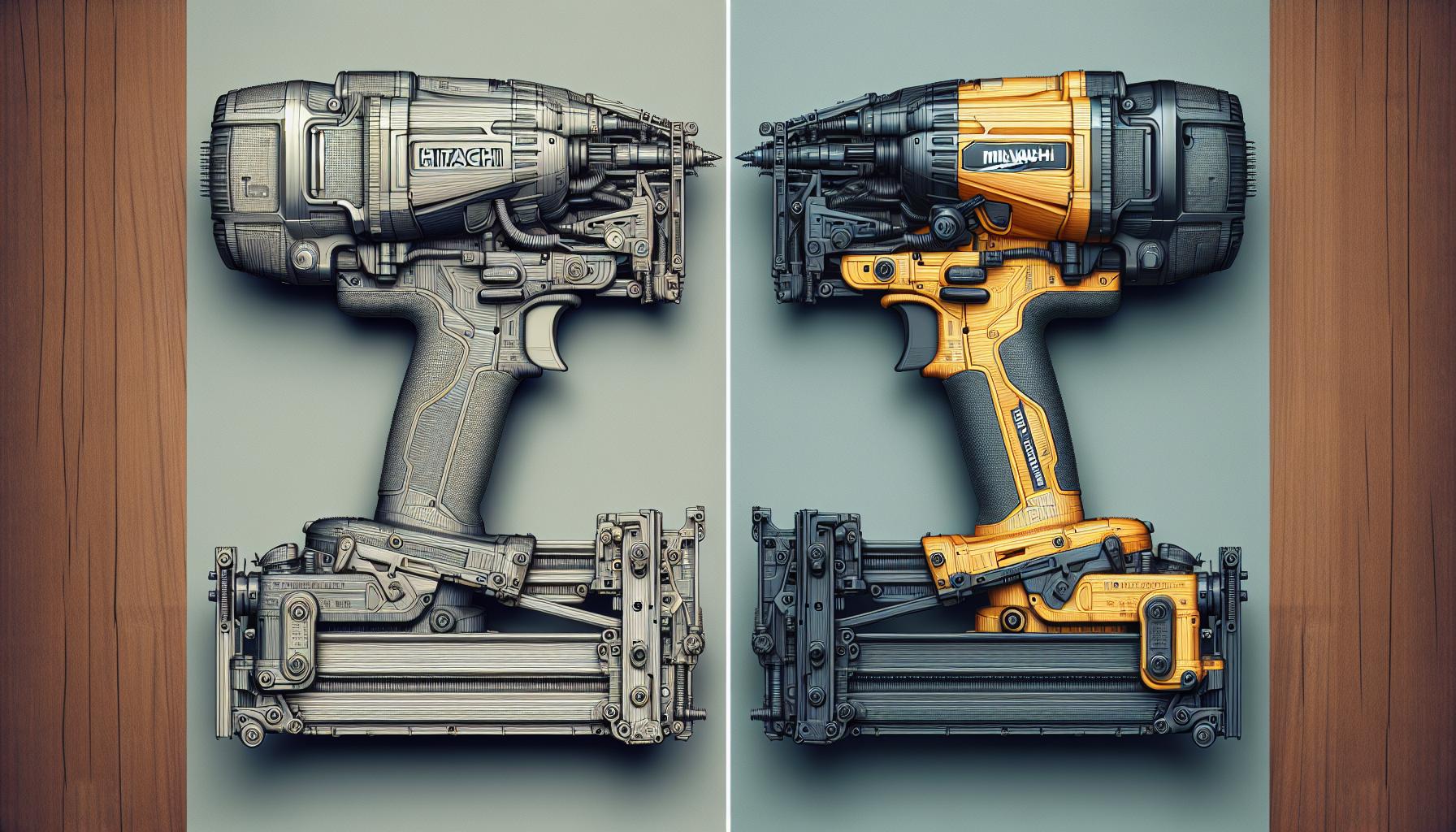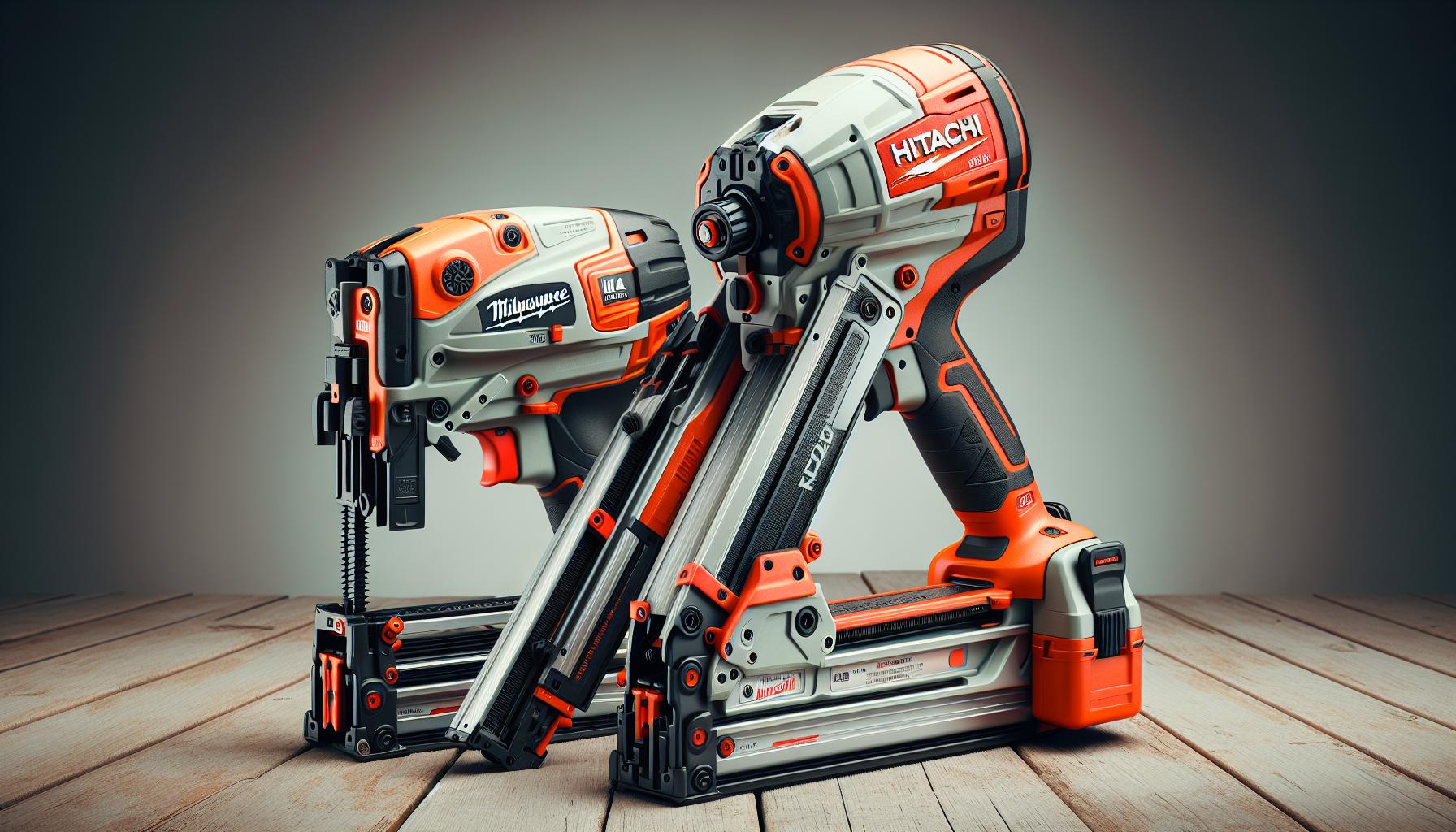When it comes to precision nailing, the right tool can make all the difference. That’s why I’m diving into the nitty-gritty of two leading contenders: the Hitachi 15 GA angle finish nailer and the Milwaukee equivalent. I’ve laid hands on both, and I’m excited to share my insights with you.
Choosing between these powerhouses isn’t just about brand loyalty; it’s about performance, durability, and the finer details that can elevate your work from good to exceptional. Let’s take a closer look at how these tools stack up against each other.
Key Features of the Hitachi 15 GA Angle Finish Nailer
When it comes to precision nailing, the Hitachi (now known as Metabo HPT) 15 GA angle finish nailer stands out with several key features that enhance its performance and reliability. Durability is a significant factor with this nailer, as it’s built with a rugged aluminum body that can withstand the rigors of heavy use. This design assures me of its longevity and resilience when tackling various projects.
Ease of use is another aspect where this tool shines. The non-slip grip fits comfortably in my hand, reducing fatigue during prolonged use. The lightweight design, weighing in at just over 4 pounds, makes it manageable for overhead work, which is a relief during longer jobs.
Included in the standout features, I’ve taken note of the selective actuation switch. This allows me to quickly shift between sequential and contact nailing with no hassle. It’s a time-saver and increases my productivity, as I don’t have to fumble around with different settings.
What I particularly appreciate is the angled magazine. It enables me to reach tighter spaces, which is often a necessity in trim work. Furthermore, a tool-free nose design for quick jam release ensures minimal downtime. I’ve found this to be a priceless feature when on a job with deadlines looming.
The exhaust port is conveniently adjustable, which means I can direct the air away from me or the workpiece. This may seem like a small detail, but it’s significant when it comes to maintaining a clear line of sight and avoiding debris in the face.
Here’s a quick rundown of the features:
- Rugged aluminum body for durability
- Comfortable non-slip grip
- Lightweight at just over 4 pounds
- Selective actuation switch for quick mode changes
- Angled magazine for hard-to-reach areas
- Tool-free nose for quick jam release
- Adjustable exhaust port
The Hitachi 15 GA nailer also offers a factory-installed air fitting that is angled upwards to keep the compressor hose conveniently out of the way. It’s these thoughtful additions that make the tool a contender for the top position in precision nailing.
Key Features of the Milwaukee Finish Nailer
Milwaukee is well-regarded in the power tool industry, and their finish nailer is no exception, boasting a bevy of features that cater to professionals and DIY enthusiasts alike. Powerstate Brushless Motor technology stands out, offering unparalleled power and efficiency. This means that when I’m working on a project, I can rely on consistent driving power and fewer stalls without the hassle of a pneumatic hose.
One aspect I appreciate about the Milwaukee finish nailer is the Redlink Plus Intelligence. This system ensures optimal performance and provides overload protection, which not only safeguards the tool but also the nails and the work surface. It’s a level of convenience that helps me work with confidence, especially when tackling delicate trim or molding pieces.
The tool’s ergonomics are another highlight. It features a smaller frame and lighter design compared to other models, allowing me to maneuver it with less strain. The tool-free depth adjustment is also a game-changer, enabling me to quickly fine-tune the nail settings for precise countersinking without interrupting my workflow.
For visibility in every nook and cranny, the Milwaukee nailer comes equipped with LED lights. This feature is extremely beneficial for illuminating the work area, enhancing accuracy in dimly lit spaces. And since jamming can bring a job to a standstill, the nailer’s easy-access nosepiece for quick jam clearing keeps me on track.
Battery life is another cornerstone of Milwaukee’s design philosophy. The finish nailer runs on their robust M18 REDLITHIUM battery system, which provides long, reliable run-time. This means less downtime spent on charging and more time nailing.
As with any high-caliber tool, safety is paramount. Milwaukee’s finish nailer doesn’t shy away here, featuring a dry-fire lockout mechanism to prevent firing when the nail count is low, protecting both the tool and the work surface from potential damage.
Performance Comparison: Hitachi vs Milwaukee
When comparing the Hitachi 15 Ga angle finish nailer to the Milwaukee model, I notice a few critical differences in performance. Hitachi, now known as Metabo HPT, is renowned for its unique air spring drive system. This system allows for rapid nailing with a quick response time, which I find exceptional during high-speed applications.
On the other hand, the Milwaukee model leverages its Powerstate Brushless Motor to deliver superior driving power. One thing’s for sure: I experience fewer stalls and interruptions with the Milwaukee, which makes it a workhorse on any project. Both nailers boast impressive run-times—thanks to Milwaukee’s M18 REDLITHIUM battery system and Hitachi’s efficient battery usage. However, the Milwaukee might edge out slightly due to its prolific battery ecosystem that supports a wide range of tools.
| Feature | Hitachi (Metabo HPT) | Milwaukee |
|---|---|---|
| Motor Technology | Air Spring Drive System | Powerstate Brushless Motor |
| Response Time | Quick | Moderate |
| Battery System | High Efficiency | M18 REDLITHIUM System |
| Driving Power | Robust for size | Superior |
| Ergonomics | Good balance and grip | Enhanced maneuverability |
| Run-Time | Long | Extended with REDLITHIUM Battery |
| Innovative Technology | Selective actuation switch | Redlink Plus Intelligence System |
I also can’t gloss over the ergonomics of each tool—Milwaukee shines with its lighter design and smaller frame. The Hitachi’s grip and balance are noteworthy, but the ease of maneuvering the Milwaukee finish nailer in tight spaces is particularly impressive. The innovative technology of the Hitachi’s selective actuation switch is user-friendly, allowing for quick transitions between sequential and contact nailing without additional tools.
While both nailers are equipped with safety features, the Milwaukee’s dry-fire lockout is something I appreciate—it prevents the tool from firing when it’s out of nails, thus extending the tool’s life and protecting the work surface.
Durability and Construction: Hitachi vs Milwaukee
Durability is a cornerstone of any high-caliber tool, and finish nailers are no exception. The Hitachi 15 Ga angle finish nailer boasts a resilient aluminum body that’s not only sturdy but also light enough for prolonged use without causing fatigue. Milwaukee’s offering counters with a reinforced magnesium frame that promises longevity while keeping the tool’s weight manageable for daily operation.
I’ve noticed that the build quality of both brands is exceptional. However, it’s the little details that set them apart. For instance, the Hitachi nailer comes with a stainless steel plating around the nose. This isn’t just for aesthetics; it resists wear from sliding on and off surfaces and constant contact with wood. Milwaukee’s commitment to durability extends to its proprietary composite materials that guard against drops and impact.
Both nailers have their share of rubber over-molds but the arrangement varies. The Hitachi’s grip is enveloped with a soft rubber that absorbs vibrations, while Milwaukee’s rubberized handle ensures a firm grip even in sweaty conditions. These design choices directly impact the longevity of the tools under heavy usage.
When it comes to maintenance, the Hitachi has an easy-to-clear nose for quick removal of jammed nails, which is crucial for minimizing downtime. Milwaukee complements its durable design with an innovative self-cleaning feature that keeps the firing mechanism clear of debris, ensuring the nailer operates smoothly over time.
Throughput is often a significant cause of wear in these tools, and both brands have tailored their designs to handle high volumes. They’ve integrated robust parts where it matters most, like the driving blade and the firing pin, to ensure that they can stand up to the rigorous demands of job sites and DIY projects alike.
Ergonomics and Ease of Use: Hitachi vs Milwaukee
When choosing a finish nailer, ergonomics plays a critical role in daily operation. I’ve found that the Hitachi 15 Ga angle finish nailer is designed with a user-friendly grip that contours comfortably to the hand. Its lightweight nature reduces fatigue during extended use. Hitachi has focused on making the nailer as balanced as possible, which contributes to precision nail placement and control.
Milwaukee, on the other hand, has incorporated several features aimed at enhancing ease of use. The tool’s ergonomic design includes a slim, tactile grip that suits a wider range of hand sizes. The balance of the tool is noticeably centered, offering stability when nailing at various angles. Milwaukee’s nailer also boasts a quick and straightforward depth-adjustment setting, which allows me to adapt to different materials efficiently.
One key aspect I can’t overlook is how well each nailer performs in terms of loading mechanisms. The Hitachi 15 Ga is equipped with a straightforward magazine setup that’s a breeze to reload, even with gloves. Milwaukee’s magazine design is equally notable for its simplicity, ensuring minimal downtime when replenishing nails. Here’s a glance at the technical specifications:
| Feature | Hitachi 15 Ga Angle Finish Nailer | Milwaukee Angle Finish Nailer |
|---|---|---|
| Weight | Lightweight | Well balanced |
| Grip | User-Friendly Contoured | Tactile, Slim Design |
| Balance | Evenly Distributed | Centered Stability |
| Depth Adjustment | Manual Dial | Easy-to-Use Switch |
| Magazine Loading | Straightforward | Simple and Efficient |
Beyond the technical details, it’s vital to discuss how each tool fares after hours of continuous work. I’ve noticed that my hands are less strained after using the Hitachi, thanks to the vibration-absorbing grip. Milwaukee’s grip, while firm, doesn’t offer the same level of vibration reduction, but the overall ergonomic design compensates by preventing slippage and helping me maintain a solid handle on the tool throughout the day.
Pricing and Value for Money: Hitachi vs Milwaukee
When investing in power tools, price is a pivotal factor for most buyers, and it’s here that the Hitachi 15 Ga angle finish nailer and the Milwaukee counterpart go head-to-head. In my experience, Hitachi typically offers more competitive pricing. However, it’s crucial to assess not just the price tag but also the overall value for money.
Hitachi nailers are often seen as a cost-effective choice for those who need reliable performance without breaking the bank. This doesn’t mean they’re cheaply made; on the contrary, Hitachi manages to blend affordability with functionality, giving users more bang for their buck. The key is their longevity and the company’s solid reputation for durable tools.
On the other side, Milwaukee nailers might come with a higher initial cost. But what you’re paying for is the brand’s commitment to innovation and quality. I’ve noticed that Milwaukee tools, including their finish nailers, often include advanced features and robust construction. They’re designed for professionals who demand the best and are willing to invest in their tools accordingly.
Let’s break down the costs:
| Brand | Average Price Range |
|---|---|
| Hitachi | $120 – $250 |
| Milwaukee | $150 – $300 |
While the prices reflect the brand status and product quality, it’s important to factor in the cost of maintenance and the availability of affordable parts. Hitachi scores well on this account with easily accessible spare parts. Meanwhile, Milwaukee’s durable build means less frequent maintenance, which could save money in the long run. The warranty and customer service from both brands also factor into the overall value, with each offering extensive support and guarantees for their products.
By comparing the pricing and what you receive for that price, it’s clear that both Hitachi and Milwaukee have positioned themselves as leaders in the finish nailer market. Your choice depends on what you value more: upfront savings with Hitachi or the long-term investment in Milwaukee’s cutting-edge technology.
Conclusion
Deciding between the Hitachi 15 Ga angle finish nailer and the Milwaukee model boils down to what’s most important to you. If your budget is tight and you’re looking for a tool that won’t let you down, Hitachi’s offering might be the way to go. It’s a solid, no-frills choice that’ll serve you well on numerous projects. But if you’re all about embracing the latest technology and don’t mind investing a bit more for top-notch quality, Milwaukee’s advanced features are sure to impress. Remember, it’s not just about the purchase price—it’s the long-term value that counts. So weigh your options, consider the kind of work you’ll be doing, and choose the nailer that aligns with your needs. Whatever your decision, you’re getting a tool that’s built to perform.
Frequently Asked Questions
Which is more cost-effective, Hitachi or Milwaukee nailers?
Hitachi nailers are generally seen as more cost-effective due to their competitive pricing and reliable performance. They offer good durability without breaking the bank.
Are Milwaukee nailers worth the higher initial cost?
Milwaukee nailers may have a higher initial cost but are known for their innovation, quality, advanced features, and can be seen as a long-term investment.
What should I consider when choosing between Hitachi and Milwaukee?
When choosing between Hitachi and Milwaukee, consider the cost of maintenance, availability of affordable parts, warranty, and customer service in addition to the upfront cost and features.
How important is the warranty when purchasing a nailer?
The warranty is an important factor to consider as it ensures long-term support and potential savings on future repairs, giving peace of mind with your purchase.
How does the availability of parts affect my choice?
The availability of affordable parts is crucial for maintenance and longevity of your nailer. It can greatly influence the total cost of ownership and hassle over time.



Reader Interactions